Leg works
The Victoria & Albert Museum’s Men in Skirts exhibition questions the notion that skirts have to be feminine.

Still viewed as the preserve of the poseur, the freak, or the Scot, the skirt has to go some length to convince men of its sartorial validity. But with the acknowledged ‘coolest man in the world’, Samuel L Jackson, kilting up in recent film 51st State, perhaps the time has come for a rethink.
The Victoria & Albert Museum taps into the widespread unease about what is seen as cross-dressing with Men in Skirts – an exhibition which, to its credit, isn’t just a survey of designers’ interpretations of the garment, but an attempt to examine some of the gender perceptions inherent in dress.
Many of the garments are deliberately provocative. Manchester-based Clone Zone skirt the boundaries of common decency with a selection of gay clubbing and fetish wear: a camouflage kilt denotes a novel twist on the combat-wear trend, a leather kilt with rear opening pleats and studded leather sporran and a gladiatorially inspired rubber skirt.
The countercultural thrust of fashion and rock have often gone hand in hand, evidenced by Vivienne Westwood’s notorious punk bondage trousers, complete with apron, and a series of Anna Sui and John-Charles Castelbajac men’s dresses inspired by grunge and Kurt Cobain’s celebrated dalliance with wife Courtney Love’s babydoll slips.
There is also room for a little self-reference. Walter van Beirendonck’s tiny miniskirt forms part of a futuristic ensemble with boned jacket and full-length latex body stocking and a red-tinted full-face sun visor; a playful extrapolation of what designer Rudi Gernreich, who commented that the male skirt would be commonplace by the 1980s, might have expected from the 21st century.
However, there is a lot more to Men in Skirts than mere shock value. The exhibition demonstrates the influence of non-Western cultures on designers, where sarongs, kaftans and kimonos are an integral part of male dress, when attempting to deconstruct the idea that skirts have to be ‘feminine’.
Paul Smith and Dolce & Gabbana sarongs stand beside a classy Moschino suit, featuring a Middle Eastern djellaba instead of trousers. In Japan, it is not the cut of the garment but the patterning that defines gender, adding street-cred to Hardy Blechman’s kimono-inspired creation for Maharishi. Hilfiger’s Tommy Tartan brand and a popular Uth sarong reveal that even the high street has flirted with the idea of men in skirts.
The most pervasive design presence is John Paul Gaultier, who has consistently carried the torch for men in skirts. Twelve garments are exhibited, taken mostly from his 1985 Et Dieu Créa L’Homme collection.
The eternal optimist, Gaultier remains committed to the idea that the embedded notions of gender identity can be overcome, but within reason: ‘Putting a skirt on a man is not a travesty. Putting a bra on him is,’ he has said.
What is most impressive about Men in Skirts is curator Andrew Bolton’s celebration of masculinity through an unconventional garment. Considering neither samurai nor David Beckham are averse to wearing skirts, the exhibition might even offer a few design ideas for England fans on tour at this summer’s World Cup Finals. St George wraparound anyone?
Men in Skirts is curated by Andrew Bolton, joint research fellow at the Victoria & Albert Museum and London College of Fashion. The exhibition runs from 8 February to 12 May in the Dress Gallery, V&A Museum, London SW7, with a Men in Skirts Fashion in Motion catwalk show on 27 February at 8pm. The book Men in Skirts, by Andrew Bolton, will be published by V&A Publications in June
-
Post a comment




